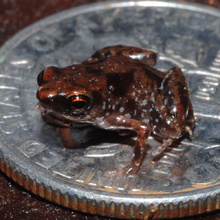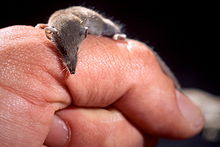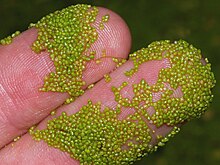Smallest organisms
The smallest organisms found on Earth can be determined according to various aspects of organism size, including volume, mass, height, length, or genome size.
Given the incomplete nature of scientific knowledge, it is possible that the smallest organism is undiscovered. Furthermore, there is some debate over the definition of life, and what entities qualify as organisms; consequently the smallest known organism (microorganism) is debatable.
Microorganisms
Obligate endosymbiotic bacteria
The genome of
The genome of Nanoarchaeum equitans is 491 Kbp nucleotides long.[citation needed]
Pelagibacter ubique
Mycoplasma genitalium
Nanoarchaeum

Eukaryotes (Eukaryota)
Viruses
Some
The smallest viruses in terms of genome size are single-stranded DNA (
The smallest
]Animals (Animalia)
Several species of
Molluscs (Molluska)
Bivalvia
The shell of the nut clam Condylonucula maya grows 0.54 mm (0.021 in) long.[14]
Gastropods (Gastropoda)

The smallest water snail (of all snails) is Ammonicera minortalis in North America, originally described from Cuba. It measures 0.32 to 0.46 mm (0.013 to 0.018 in).[15][16]
The smallest land snail is Acmella nana. Discovered in Borneo, and described in November 2015, it measures 0.7 mm (0.028 in).[17] The previous record was that of Angustopila dominikae from China, which was reported in September 2015. This snail measures 0.86 mm (0.034 in).[18]
Cephalopods (Cephalopoda)
Maximites was the smallest known ammonoid. Adult specimens reached only 10 mm (0.39 in) in shell diameter.[19]
Arthropods (Arthropoda)
The smallest arthropods are
Arachnids (Arachnida)
- There is a debate about which spider is smallest. According to Guinness World Records, "Two contenders are from the Symphytognathidae genus Patu: males of Patu digua described in Colombia had a body length of 0.37 millimetres (0.015 inches), while the Samoan moss spider (P. marplesi) could be as small as 0.4 millimetres (0.016 inches) long."[22] Other possible smallest spider species are the Frade cave spider known as Anapistula ataecina, and the dwarf orb weaver (Anapistula caecula), the females of which are 0.43 mm (0.017 in) and 0.48 mm (0.019 in) respectively.[22] Males of both species are potentially smaller than the females, but no Anapistula ataecina or Anapistula caecula have been measured yet.[22]
- Cochlodispus minimus is the smallest mite. An adult individual measured with a body length of 79 μm (0.079 mm).[23] However, PBS claims "The tiniest mite on record is 82 microns long" but does not name a species.[24]
Insects (Insecta)
- Adult males of the parasitic wasp Dicopomorpha echmepterygis can be as small as 139 μm (0.139 mm) long, smaller than some species of protozoa (single-cell creatures); females are 40% larger.[25] Megaphragma caribea from Guadeloupe, measuring 170 μm (0.17 mm) long, is another contender for smallest known insect in the world.
- Scydosella musawasensis at 325 μm (0.325 mm) long; a few other nanosellines are reportedly smaller, in historical literature, but none of these records have been confirmed using accurate modern tools. These are among the tiniest non-parasitic insects.[26]

- The butterflies in the world, with a wingspan of about 1 cm (0.39 in).[27]
Echinoderms (Echinodermata)
The smallest sea cucumber, and also the smallest echinoderm, is Psammothuria ganapati, a synaptid that lives between sand grains on the coast of India. Its maximum length is 4 mm (0.16 in).[28] [29]
Sea urchins
The smallest sea urchin, Echinocyamus scaber, has a test 6 mm (0.24 in) across.[29]
Starfish
Fish (Pisces)
- One of the smallest standard length.[30] This fish, a member of the carp family, has a translucent body and a head unprotected by a skeleton.
- One of the smallest fish based on the minimum size at maturity is anal fin ray further forward, under dorsal fin4.
- Male individuals of the Photocorynus spiniceps have been documented to be 6.2–7.3 mm (0.24–0.29 in) at maturity, and thus claimed to be a smaller species. However, these survive only by sexual parasitism and the female individuals reach the significantly larger size of 50.5 mm (1.99 in).[33][34][35][36]
Amphibians (Amphibia)
Frogs and toads (Anura)


The smallest vertebrates (and smallest amphibians) known are Paedophryne amauensis frogs from Papua New Guinea, which range in length from 7.0–8.0 mm (0.28–0.31 in), and average 7.7 mm (0.30 in).[37][38] Other very small frogs include:
- Brachycephalus didactylusfrom Brazil (reported as 9.6–9.8 mm (0.38–0.39 in))
- several species of E. limbatus (8.5–12 mm (0.33–0.47 in)) and Eleutherodactylus orientalis(12.5 mm (0.49 in)) from Cuba,
- Gardiner's Frog Sechellophryne gardinerifrom the Seychelles (up to 11 mm (0.43 in)),
- several species of Stumpffia such as S. tridactyla (8.6–12 mm (0.34–0.47 in)) and S. pygmaea (males 10–12.5 mm (0.39–0.49 in); females: 11 mm (0.43 in)) and Wakea madinika (males: 11–13 mm (0.43–0.51 in); females: 15–16 mm (0.59–0.63 in)) from Madagascar.
Paedophryne swiftorum (body length 8.5 mm (0.33 in)) is not included in the smallest vertebrates known with other nine species of frogs.[39] The two species Microhyla borneensis (males: 10.6–13 mm (0.42–0.51 in); females: 16–19 mm (0.63–0.75 in))[40][41] and Arthroleptella rugosa (males: 11.9–14.1 mm (0.47–0.56 in); females: 15.5 mm (0.61 in)) were once the smallest known frogs from the Old World. In general these extremely small frogs occur in tropical forest and montane environments. There is relatively little data on size variation among individuals, growth from metamorphosis to adulthood or size variation among populations in these species. Additional studies and the discovery of further minute frog species are likely to change the rank order of this list.
Salamanders, newts and allies (Urodela)
The average snout-to-vent length (SVL) of several specimens of the salamander Thorius arboreus was 17 mm (0.67 in).[citation needed]
Sauropsids (Sauropsida)
Lizards and snakes (Squamata)

- The

- One of the smallest known
Turtles and tortoises (Testudines)
The smallest
Archosaurs (Archosauria)[note 1]
Crocodiles and close relatives (Crocodylomorpha)
- The smallest extant crocodilian is the Cuvier's dwarf caiman (Paleosuchus palpebrosus) from northern and central South America. It reaches up to 1.6 m (5.2 ft) in length.[52]
- Some extinct crocodylomorphs were even smaller.[53] Fully grown Bernissartia from the Early Cretaceous reached a bit more than 60 cm (24 in) in length.[54]
- The Early Cretaceous terrestrial notosuchian Malawisuchus was no more than 60 cm (24 in) long.[55] Other small notosuchians include Anatosuchus at 70 cm (28 in)[56] and herbivorous Simosuchus at 75 cm (30 in).[57]
Pterosaurs (Pterosauria)
Nemicolopterus was the smallest pterosaur, it reached about 25 cm (9.8 in) in wingspan.[58]
Non-avian dinosaurs (Dinosauria)
Sizes of non-avian dinosaurs are commonly labelled with a level of uncertainty, as the available material often (or even usually) is incomplete. The smallest known extinct non-avian
Birds (Aves)

- With a mass of approximately 1.95 grams (0.069 oz) and a length of 5.5 centimetres (2.2 inches), the body massand drinks eight times its total body mass each day. Its nest is 3 cm (1.2 in) across.
- The smallest Nettapus). African species reaches the average weight of about 285 grams (10.1 oz) for males and 260 grams (9.2 oz) for females and wingspans between 142 millimetres (5.6 in) and 165 millimetres (6.5 in).[65] The second smallest waterfowl is the extinct Mioquerquedula from the Miocene.[66]
- The smallest penguin species is the little blue penguin (Eudyptula minor), which stands around 30–33 cm (12–13 in) tall and weighs 1.2–1.3 kg (2.6–2.9 lb).[67]
- The smallest bird of prey is the Black-thighed falconet (Microhierax fringillarius), with a wingspan of 27–32 centimetres (11–13 in), roughly the size of a sparrow.[68]
Non-mammalian synapsids (Synapsida)
The smallest Mesozoic mammaliaform was Hadrocodium with a skull of 1.5 cm (0.59 in) in length and a body mass of 2 g (0.071 oz).[69]
Mammals (Mammalia)
Marsupials (Marsupialia)
The smallest
Shrews (Eulipotyphla)

The Etruscan shrew (Suncus etruscus), is the smallest mammal by mass, weighing about 1.8 g (0.063 oz) on average.[71] The smallest mammal that ever lived, the shrew-like Batodonoides vanhouteni, weighed 1.3 grams (0.046 oz).[72]
Bats (Chiroptera)
The Kitti's hog-nosed bat (Craseonycteris thonglongyai), also known as the bumblebee bat, from Thailand and Myanmar[73] is the smallest mammal, at 29–33 millimetres (1.1–1.3 in) in length and 2 grams (0.071 oz) in weight.[74][75]
Carnivorans (Carnivora)
The smallest member of the order Carnivora is the least weasel (Mustela nivalis), with an average body length of 114–260 mm (4.5–10.2 in). It weighs between 29.5–250 g (1.04–8.82 oz) with females being lighter.[citation needed]
Rodents (Rodentia)
The smallest known member of the rodent order is the Baluchistan pygmy jerboa, with an average body length of 4.4 cm (1.7 in).[70]
Primates (Primates)
The smallest member of the primate order is Madame Berthe's mouse lemur (Microcebus berthae), found in Madagascar,[76] with an average body length of 9.2 cm (3.6 in).
Cetaceans (Cetacea)
The smallest cetacean, which is also (as of 2006) the most endangered, is the vaquita, a species of porpoise. Male vaquitas grow to an average of around 135 cm (53 in); the females are slightly longer, averaging about 141 cm (56 in) in length.[citation needed]
Plants (Plantae)
Gymnosperms (Gymnospermae)
Zamia pygmaea is a cycad found in Cuba, and the smallest known gymnosperm.[77] It grows to a height of 25 cm (10 in).[78]
Angiosperms (Angiospermae)

Dicotyledons
The smallest known
Other
Nanobes
Nanobes are thought by some scientists to be the smallest known organisms,[81] about one tenth the size of the smallest known bacteria. Nanobes, tiny filamental structures first found in some
See also
- Largest organisms
- Largest prehistoric organisms
Notes
- reptiles.
References
- PMID 26798106.
- ^ "Pelagibacter ubique - microbewiki". microbewiki.kenyon.edu. Retrieved 19 April 2018.
- ^ "Re: What is the smallest living thing?". Madsci.org. Retrieved 2013-10-03.
- PMID 23038175.
- S2CID 4206886.
- PMID 19647885.
- ^ ICTVdB Virus Description – 00.016.0.01.005. Porcine circovirus 2 Archived July 4, 2007, at the Wayback Machine
- PMID 26217327.
- PMID 23842650.
- ^ "Enterobacteria phage BZ13 strain T72, complete genome". 2008.
- ISBN 0-87969-571-4.
- ^ Fiala, Ivan. 2008. Myxozoa. Version 10 July 2008 (under construction). http://tolweb.org/Myxozoa/2460/2008.07.10 in The Tree of Life Web Project, http://tolweb.org/
- PMID 23024499.
- .
- PMID 26478698.
- ^ Sankar-Gorton, Eliza (4 November 2015). "Newly Discovered Land Snail Is The Tiniest In The World". HuffPost. Retrieved 9 November 2015.
- ^ Geggel, Laura (2 November 2015). "Micro Mollusk Breaks Record for World's Tiniest Snail". LiveScience. Retrieved 8 November 2015.
- PMID 26478698.
- ^ Nishiguchi MK, Mapes R (2008). "Cephalopoda". In Ponder W, Lindberg D (eds.). Phylogeny and Evolution of the Mollusca (PDF). University of California Press. pp. 162–199.
- PMID 20852984.
- ^ Joel W. Martin & George E. Davis (2001). An Updated Classification of the Recent Crustacea (PDF). Natural History Museum of Los Angeles County. pp. 132 pp. Archived from the original (PDF) on October 10, 2008.
- ^ a b c "Smallest spider". Guinness World Records. Retrieved 2021-04-16.
- ISSN 1314-2607.
- ^ "Meet the mite, the tiny bugs in your mattress, your tea and on your face". PBS NewsHour. 2016-09-02. Retrieved 2021-04-16.
- ^ "University of Florida Book of Insect Records". Entnemdept.ifas.ufl.edu. 1998-04-17. Archived from the original on 2013-10-05. Retrieved 2013-10-03.
- PMID 26487824.
- ^ "Facts on the Western Pygmy Blue Butterfly".
- S2CID 135202924.
- ^ ISBN 0-7565-1611-0.
- ^ Froese, Rainer; Pauly, Daniel (eds.) (2017). "Paedocypris progenetica" in FishBase. September 2017 version.
- The Australian Museum. June 2020. Archived from the originalon October 3, 2022. Retrieved February 14, 2019.
- ^ Froese, Rainer; Pauly, Daniel (eds.) (2017). "Schindleria brevipinguis" in FishBase. September 2017 version.
- ^ "Scientists find 'smallest fish'". BBC News. 2006-01-25. Retrieved 2010-05-23.
- ^ "What is the smallest species of fish?". Amonline.net.au. 2013-09-27. Archived from the original on February 20, 2009. Retrieved 2013-10-03.
- ^ "Smallest fish compete for honours". BBC News. 2006-01-31. Retrieved 2010-05-23.
- ^ "Bragging Rights: The Smallest Fish Ever | LiveScience". Live Science. Archived from the original on July 6, 2008.
- ^ "World's tiniest frogs found in Papua New Guinea". The Australian. 12 January 2012. Retrieved 11 January 2012.
- PMID 22253785.
- ^ Krishna Ramanujan (2012-03-29). "Student researchers help discover world's smallest frog". Cornell Chronicle. Retrieved 2012-01-03.
- ^ "Tiny, new, pea-sized frog is old world's smallest". ScienceDaily.
- ^ "Bornean Chorus Frog - Microhyla borneensis (Microhyla nepenthicola)". ecologyasia.com.
- ^ Pennsylvania State University (2001). World's Smallest Lizard Discovered in the Caribbean. Retrieved 26 January 2009.
- ^ "Tiny gecko is 'world's smallest'". BBC News. 2001-12-03. Retrieved 2010-05-23.
- ^ "12/03/01 -- World's Smallest Reptile Discovered in Caribbean". Archived from the original on 2002-11-04. Retrieved 2011-12-14.
- ISBN 978-3-929449-03-7
- PMID 22348069.
- PMID 33510189.
- ^ "World's Smallest Chameleon Discovered And It's 'Surprisingly' Well-Endowed". IFLScience. Retrieved 2021-01-28.
- ^ "Indotyphlops braminus :: Florida Museum of Natural History". floridamuseum.ufl.edu. 17 August 2020.
- ^ "Blind Snakes". reptilesmagazine.com. December 2011.
- ISBN 1-86872-040-3
- ^ "Paleosuchus palpebrosus (Cuvier, 1807)". Archived from the original on 13 October 2007.
- PMID 31390981.
- S2CID 216464226.
- .
- S2CID 86329307– via ResearchGate.
- ISBN 9781118407554. Retrieved 25 September 2022.
- PMID 18268340.
- Chinese Science Bulletin, 6 pages, accepted November 15, 2008.
- ^ Which was the smallest dinosaur? Archived 2011-07-06 at the Wayback Machine Royal Tyrrell Museum. Last accessed 2008-05-23.
- S2CID 247222017.
- S2CID 4362560.
- OCLC 985402380.
- ^ "mschloe.com - Diese Website steht zum Verkauf! - Informationen zum Thema mschloe". ww1.mschloe.com. Archived from the original on July 3, 2013.
- ISBN 9780198610090.
- ^ "Dabbling Ducks (Aves: Anatidae) from the Middle Miocene of Mongolia". ResearchGate. October 2018.
- ^ Grabski, Valerie (2009). "Little Penguin – Penguin Project". Penguin Sentinels/University of Washington. Archived from the original on 16 December 2011. Retrieved 24 September 2022.
- ISBN 0-618-12762-3
- ISBN 9780198507611. Retrieved 22 September 2022.
- ^ a b "World's Smallest Animals". Thetoptenz.net. 2013-09-29. Retrieved 2013-10-03.
- PMID 12110649. Retrieved April 27, 2020.
- JSTOR 1383090.
- . Listed as Vulnerable
- ^ Donati, Annabelle, and Pamela Johnson. "Which mammal is the smallest?." I wonder which snake is the longest: and other neat facts about animal records. Racine, Wis.: Western Pub. Co., 1993. 8. Print.
- EDGE Species. Archived from the originalon 21 September 2010. Retrieved 2008-04-10.
- ^ (Retrieved on March 17, 2010). Archived July 16, 2009, at the Wayback Machine
- ISBN 978-81-224-0792-1. Retrieved 16 April 2022.
- ^ P.S.Dhami; G.Chopra; H.N.Srivastava (2015). A textbook of Biology. Jalandhar, Punjab: Pradeep Publication.
- ^ "What is the smallest flower in the world?". Loc.gov. Retrieved 2013-10-03.
- S2CID 4181798. Retrieved 16 April 2022.
- S2CID 29030837.
External links
- Featherwing beetles on the UF / IFAS Featured Creatures Web site
